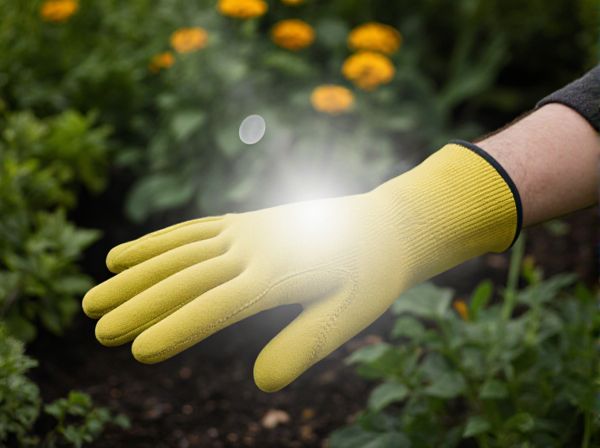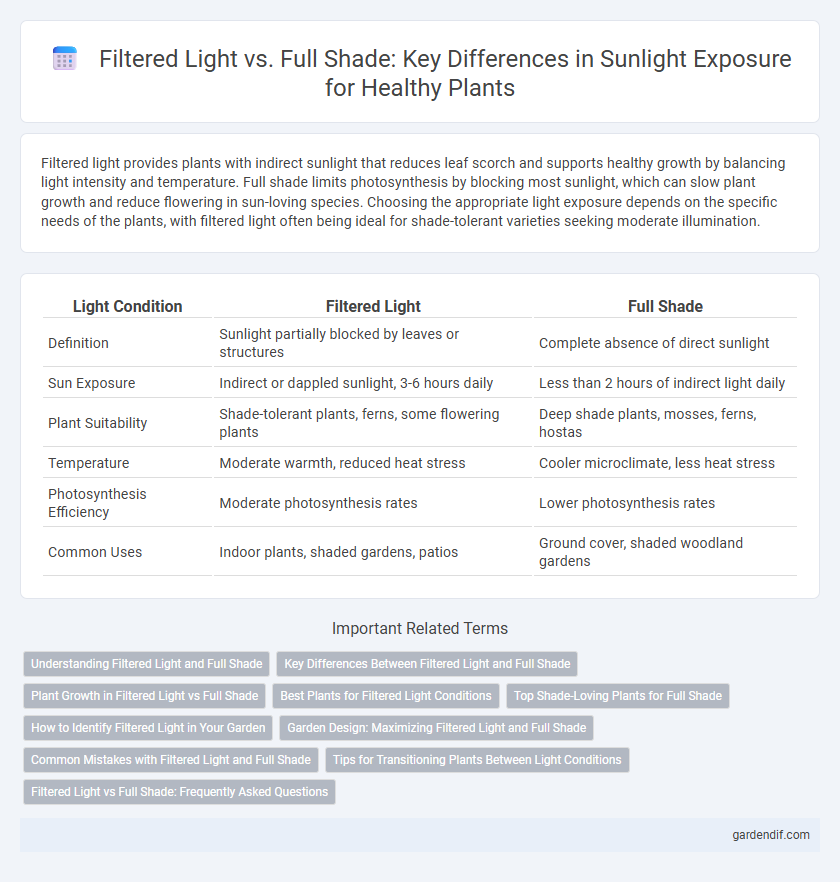
Filtered Light vs Full Shade Illustration
Filtered light provides plants with indirect sunlight that reduces leaf scorch and supports healthy growth by balancing light intensity and temperature. Full shade limits photosynthesis by blocking most sunlight, which can slow plant growth and reduce flowering in sun-loving species. Choosing the appropriate light exposure depends on the specific needs of the plants, with filtered light often being ideal for shade-tolerant varieties seeking moderate illumination.
Table of Comparison
| Light Condition | Filtered Light | Full Shade |
|---|---|---|
| Definition | Sunlight partially blocked by leaves or structures | Complete absence of direct sunlight |
| Sun Exposure | Indirect or dappled sunlight, 3-6 hours daily | Less than 2 hours of indirect light daily |
| Plant Suitability | Shade-tolerant plants, ferns, some flowering plants | Deep shade plants, mosses, ferns, hostas |
| Temperature | Moderate warmth, reduced heat stress | Cooler microclimate, less heat stress |
| Photosynthesis Efficiency | Moderate photosynthesis rates | Lower photosynthesis rates |
| Common Uses | Indoor plants, shaded gardens, patios | Ground cover, shaded woodland gardens |
Understanding Filtered Light and Full Shade
Filtered light occurs when sunlight passes through a canopy of leaves, creating dappled patterns that provide moderate brightness without direct exposure, ideal for delicate plants that require partial sunlight. Full shade refers to areas receiving less than two hours of direct sunlight daily, with the remainder dominated by indirect or reflected light, suitable for shade-tolerant species like ferns and hostas. Understanding the distinctions between filtered light and full shade informs optimal plant placement, ensuring healthy growth and photosynthesis efficiency.
Key Differences Between Filtered Light and Full Shade
Filtered light allows partial sunlight to pass through, creating dappled or diffused illumination ideal for shade-tolerant plants needing indirect light. Full shade regions receive little to no direct sunlight, often found under dense tree canopies or shaded structures, supporting plants adapted to low-light environments. The key difference lies in the intensity and quality of light; filtered light provides moderate illumination that supports photosynthesis, while full shade results in minimal light exposure, limiting plant growth to species with low light requirements.
Plant Growth in Filtered Light vs Full Shade
Plants growing in filtered light benefit from partial sunlight, which enhances photosynthesis and supports healthier, more vigorous growth compared to full shade. Filtered light provides enough energy for chlorophyll production, promoting stronger stems and vibrant foliage, whereas full shade often results in slower growth and sparse, leggy plants due to limited light availability. Optimal plant development depends on species-specific light requirements, with many shade-tolerant plants adapting better to filtered light environments than deep, full shade.
Best Plants for Filtered Light Conditions
Best plants for filtered light conditions include calatheas, ferns, and peace lilies, which thrive under indirect sunlight. These plants require moderate light that mimics dappled sunlight found beneath tree canopies, making them ideal for east-facing windows or shaded patios. Unlike full shade plants, which tolerate minimal light, filtered light plants benefit from some brightness without direct sun exposure.
Top Shade-Loving Plants for Full Shade
Top shade-loving plants thrive in full shade environments where filtered light is minimal or absent, adapting to low light conditions with lush foliage and vibrant blooms. Species like hostas, ferns, and astilbes excel in full shade, offering diverse textures and colors that brighten shaded garden areas. These plants require minimal direct sunlight, making them ideal choices for north-facing gardens or shaded undercanopies of trees.
How to Identify Filtered Light in Your Garden
Filtered light in your garden is identified by soft, dappled sunlight that passes through the canopy of trees or shrubs, creating intermittent patches of light and shade. Unlike full shade, which is consistently dark due to obstructions blocking direct sunlight, filtered light allows enough brightness to support shade-tolerant plants without subjecting them to harsh sun exposure. Observing the intensity and movement of light throughout the day helps determine areas with filtered light suitable for plants like ferns, hostas, and impatiens.
Garden Design: Maximizing Filtered Light and Full Shade
Maximizing filtered light in garden design enhances plant health by allowing dappled sunlight to nourish shade-tolerant species like ferns and hostas, promoting vibrant foliage and preventing leaf scorch. Full shade areas support shade-loving plants such as astilbes and impatiens, which thrive with minimal sunlight and contribute texture and color to darker garden corners. Strategic placement of trees and shrubs creates varying light conditions, optimizing growth zones and biodiversity within the garden landscape.
Common Mistakes with Filtered Light and Full Shade
Common mistakes with filtered light include placing sun-sensitive plants in areas receiving inconsistent light, which leads to uneven growth and stress. In full shade, a typical error is assuming all shade-tolerant plants thrive without any direct sunlight, causing slow growth or poor flowering. Understanding the specific light needs of each plant prevents these issues and promotes healthy development.
Tips for Transitioning Plants Between Light Conditions
When transitioning plants between filtered light and full shade, gradually acclimate them over two weeks to prevent shock from sudden changes in light intensity. Monitor plant responses, such as leaf color and growth patterns, to adjust the exposure time accordingly for optimal health. Use shade cloth or move plants incrementally to control light levels during the adaptation period effectively.
Filtered Light vs Full Shade: Frequently Asked Questions
Filtered light provides partial sunlight, allowing plants to receive indirect rays that promote healthy growth without the risk of leaf scorch. Full shade refers to areas receiving less than three hours of direct sunlight daily, suitable for shade-tolerant plants but often limiting photosynthesis and flowering. Frequently asked questions about filtered light versus full shade include which plants thrive best in each condition and how light intensity affects plant health and development.
Filtered Light vs Full Shade Infographic

 gardendif.com
gardendif.com